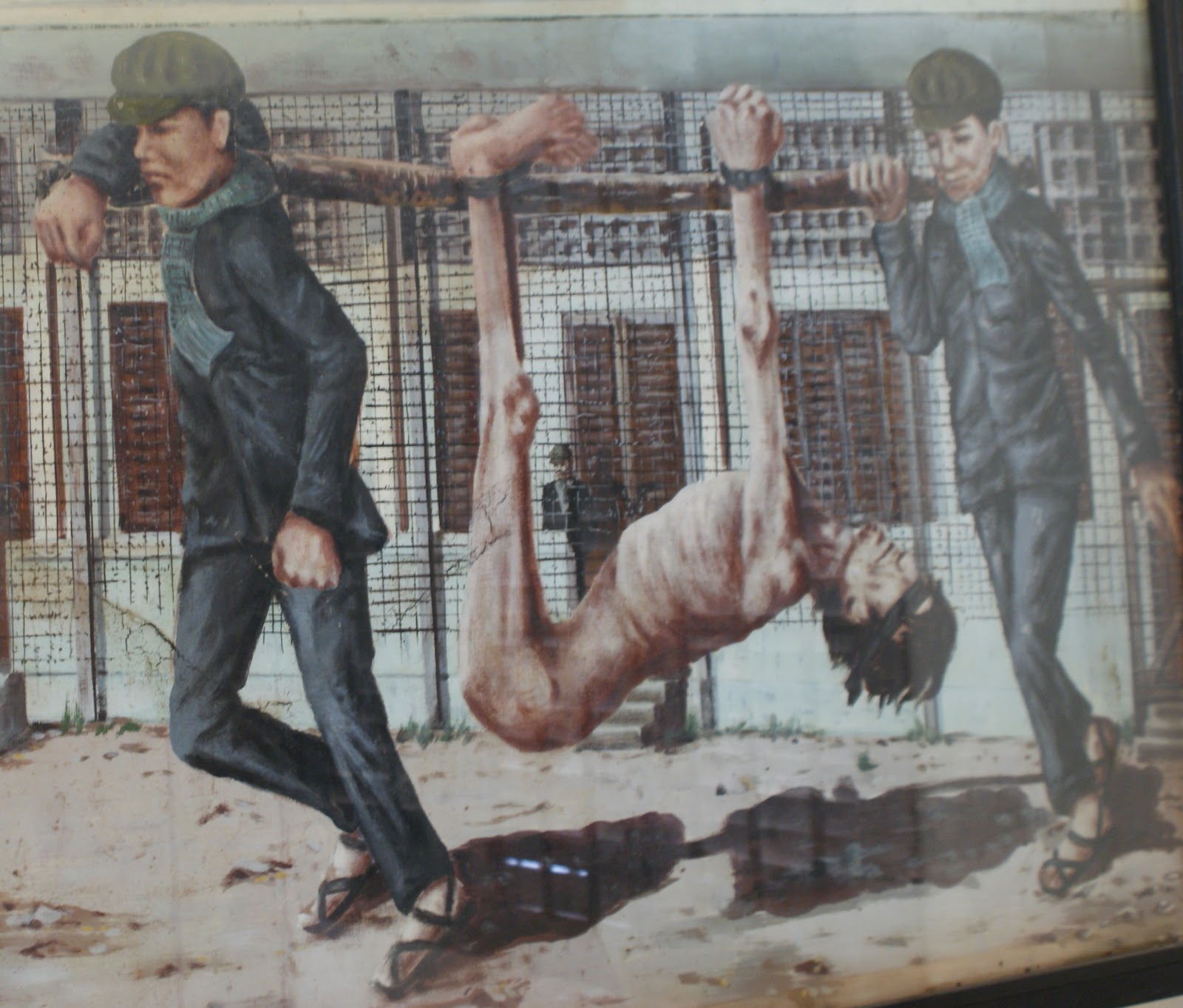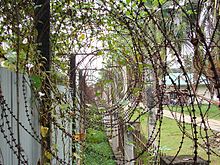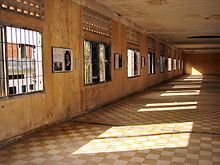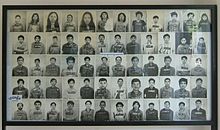Tuol Sleng Genocide Museum of cambodia
The Tuol Sleng Genocide Museum (Khmer: សារមន្ទីរឧក្រិដ្ឋកម្មប្រល័យពូជសាសន៍ទួលស្លែង) is a museum in Phnom Penh, the capital of Cambodia, chronicling the Cambodian genocide. The site is a former high school which was used as the notorious Security Prison 21 (S-21) by the Khmer Rouge regime from its rise to power in 1975 to its fall in 1979. Tuol Sleng (Khmer: ទួលស្លែង Khmer pronunciation: [tuəl slaeŋ]) means "Hill of the Poisonous Trees" or "Strychnine Hill". Tuol Sleng was just one of at least 150 execution centers established by the Khmer Rouge.[1] On the 26 July 2010, the Extraordinary Chambers in the Courts of Cambodia convicted the chief of Tuol Sleng Prison, Kaing kek Iew, (alias Duch) for crimes against humanity and grave breaches of the 1949 Geneva Conventions and sentenced him to life imprisonment.

History
Formerly the Chao Ponhea Yat High School,[3] named after a royal ancestor of King Norodom Sihanouk, the five buildings of the complex were converted in August 1975, four months after the Khmer Rouge won the Cambodian Civil War,[4] into a prison and interrogation center. The Khmer Rouge renamed the complex "Security Prison 21" (S-21) and construction began to adapt the prison to the inmates: the buildings were enclosed in electrified barbed wire, the classrooms converted into tiny prison and torture chambers, and all windows were covered with iron bars and barbed wire to prevent escapes.
From 1975 to 1979, an estimated 17,000 people were imprisoned at Tuol Sleng (some estimates suggest a number as high as 20,000, although the real number is unknown). At any one time, the prison held between 1,000–1,500 prisoners. They were repeatedly tortured and coerced into naming family members and close associates, who were in turn arrested, tortured and killed. In the early months of S-21's existence, most of the victims were from the previous Lon Nol regime and included soldiers, government officials, as well as academics, doctors, teachers, students, factory workers, monks, engineers, etc. Later, the party leadership's paranoia turned on its own ranks and purges throughout the country saw thousands of party activists and their families brought to Tuol Sleng and murdered.[3] Those arrested included some of the highest ranking communist politicians such as Khoy Thoun, Vorn Vet and Hu Nim. Although the official reason for their arrest was "espionage", these men may have been viewed by Khmer Rouge leader Pol Pot as potential leaders of a coup against him. Prisoners' families were often brought en masse to be interrogated and later executed at the Choeung Ek extermination center.
In 1979, the prison was uncovered by the invading Vietnamese army. In 1980, the prison was reopened by the government of the People's Republic of Kampuchea as a historical museum memorializing the actions of the Khmer Rouge regime.
Upon arrival at the prison, prisoners were photographed and required to give detailed autobiographies, beginning with their childhood and ending with their arrest. After that, they were forced to strip to their underwear, and their possessions were confiscated. The prisoners were then taken to their cells. Those taken to the smaller cells were shackled to the walls or the concrete floor. Those who were held in the large mass cells were collectively shackled to long pieces of iron bar. The shackles were fixed to alternating bars; the prisoners slept with their heads in opposite directions. They slept on the floor without mats, mosquito nets, or blankets. They were forbidden to talk to each other.[3]
The day in the prison began at 4:30 a.m. when prisoners were ordered to strip for inspection. The guards checked to see if the shackles were loose or if the prisoners had hidden objects they could use to commit suicide. Over the years, several prisoners managed to kill themselves, so the guards were very careful in checking the shackles and cells. The prisoners received four small spoonfuls of rice porridge and watery soup of leaves twice a day. Drinking water without asking the guards for permission resulted in serious beatings. The inmates were hosed down every four days.[3]
The prison had very strict regulations, and severe beatings were inflicted upon any prisoner who tried to disobey. Almost every action had to be approved by one of the prison's guards. They were sometimes forced to eat human faeces and drink human urine.[5] The unhygienic living conditions in the prison caused skin diseases, lice, rashes, ringworm and other ailments. The prison's medical staff were untrained and offered treatment only to sustain prisoners’ lives after they had been injured during interrogation. When prisoners were taken from one place to another for interrogation, their faces were covered. Guards and prisoners were not allowed to converse. Moreover, within the prison, people who were in different groups were not allowed to have contact with one another.
Torture and extermination
Most prisoners at S-21 were held there for two to three months. However, several high-ranking Khmer Rouge cadres were held longer. Within two or three days after they were brought to S-21, all prisoners were taken for interrogation.[3] The torture system at Tuol Sleng was designed to make prisoners confess to whatever crimes they were charged with by their captors. Prisoners were routinely beaten and tortured with electric shocks, searing hot metal instruments and hanging, as well as through the use of various other devices. Some prisoners were cut with knives or suffocated with plastic bags. Other methods for generating confessions included pulling out fingernails while pouring alcohol on the wounds, holding prisoners’ heads under water, and the use of the waterboarding technique (see picture). Women were sometimes raped by the interrogators, even though sexual abuse was against Democratic Kampuchea (DK) policy. The perpetrators who were found out were executed.[3] Although many prisoners died from this kind of abuse, killing them outright was discouraged, since the Khmer Rouge needed their confessions. The "Medical Unit" at Tuol Sleng, however, did kill at least 100 prisoners by bleeding them to death.[6] Medical experiments were performed on certain prisoners. Inmates were sliced open and had organs removed with no anesthetic. Others were attached to intravenous pumps and every drop of blood was drained from their bodies to see how long they could survive. The most difficult prisoners were skinned alive.[7]
In their confessions, the prisoners were asked to describe their personal background. If they were party members, they had to say when they joined the revolution and describe their work assignments in DK. Then the prisoners would relate their supposed treasonous activities in chronological order. The third section of the confession text described prisoners’ thwarted conspiracies and supposed treasonous conversations. At the end, the confessions would list a string of traitors who were the prisoners’ friends, colleagues, or acquaintances. Some lists contained over a hundred names. People whose names were in the confession list were often called in for interrogation.[3]
Typical confessions ran into thousands of words in which the prisoner would interweave true events in their lives with imaginary accounts of their espionage activities for the CIA, the KGB, or Vietnam. Physical torture was combined with sleep deprivation and deliberate neglect of the prisoners. The torture implements are on display in the museum. It is believed that the vast majority of prisoners were innocent of the charges against them and that the torture produced false confessions.
For the first year of S-21’s existence, corpses were buried near the prison. However, by the end of 1976, cadres ran out of burial spaces, the prisoner and their family were taken to the Boeung Choeung Ek (“Crow’s Feet Pond”) extermination centre, fifteen kilometers from Phnom Penh.[8] There, they were killed by a group of teenagers led by a Comrade Teng[8] being battered with iron bars, pickaxes, machetes and many other makeshift weapons owing to the scarcity, and subsequent price of ammunition. After the prisoners were executed, the soldiers who had accompanied them from S-21 buried them in graves that held as few as 6 and as many as 100 bodies.[3]



Non-Cambodians in the prison
Even though the vast majority of the victims were Cambodian, some foreigners, including 488 Vietnamese, 31 Thai, 1 Laotian, 1 Arab, 1 British, 4 French, 2 Americans, 1 New Zealander, 2 Australians, 1 Indonesian,[9] many Indians and Pakistanis were also imprisoned.
Almost all non-Cambodians had left the country by early May 1975, following an overland evacuation of the French Embassy in trucks. The few who remained were seen as a security risk. Though most of the foreign victims were either Vietnamese or Thai,[10] a number of Western prisoners, many picked up at sea by Khmer Rouge patrol boats, also passed through S-21 between April 1976 and December 1978. No foreign prisoners survived captivity in Tuol Sleng.
Two Franco-Vietnamese brothers named Rovin and Harad Bernard were detained in April 1976 after they were transferred from Siem Reap where they had worked tending cattle.[11] Another Frenchman named Andre Gaston Courtigne, a 30-year-old clerk and typist at the French embassy, was arrested the same month along with his Khmer wife in Siem Reap.[12]
It is possible that a handful of French nationals who went missing after the 1975 evacuation of Phnom Penh also passed through S-21.[11] Two Americans were captured under similar circumstances. James Clark and Lance McNamara in April 1978 were sailing when their boat drifted off course and sailed into Cambodian waters. They were arrested by Khmer patrol boats, taken ashore, where they were blindfolded, placed on trucks, and taken to the then deserted Phnom Penh.
Twenty-six-year-old John D. Dewhirst, a British tourist, was one of the youngest foreigners to die in the prison.[13] He was sailing with his New Zealand companion, Kerry Hamill, and their Canadian friend Stuart Glass when their boat drifted into Cambodian territory and was intercepted by Khmer patrol boats on August 13, 1978. Glass was killed during the arrest, while Dewhirst and Hamill were captured, blindfolded, and taken to shore. Both were executed, with Dewhirst possibly having been burned alive, after having been tortured for several months at Tuol Sleng.[7]
One of the last foreign prisoners to die was twenty-nine-year-old American Michael S. Deeds, who was captured with his friend Christopher E. DeLance on November 24, 1978 while sailing from Singapore to Hawaii. His confession was signed a week before the Vietnamese army invaded Cambodia and ousted the Khmer Rouge. In 1989, Deeds's brother, Karl Deeds, traveled to Cambodia in attempts to find his brother's remains, but was unsuccessful.[14] On September 3, 2012, DeLance's photograph was identified among the caches of inmate portraits.[15]
As of 1999, there were a total of 79 foreign victims on record,[10] but former Tuol Sleng Khmer Rouge photographer Nim Im claims that the records are not complete. On top of that, there is also an eyewitness account of a Cuban and a Swiss who passed through the prison, though no official records of one was shown.[16].
Survivors of Tuol Sleng
Even though the vast majority of the victims were Cambodian, some foreigners, including 488 Vietnamese, 31 Thai, 1 Laotian, 1 Arab, 1 British, 4 French, 2 Americans, 1 New Zealander, 2 Australians, 1 Indonesian,[9] many Indians and Pakistanis were also imprisoned.
Almost all non-Cambodians had left the country by early May 1975, following an overland evacuation of the French Embassy in trucks. The few who remained were seen as a security risk. Though most of the foreign victims were either Vietnamese or Thai,[10] a number of Western prisoners, many picked up at sea by Khmer Rouge patrol boats, also passed through S-21 between April 1976 and December 1978. No foreign prisoners survived captivity in Tuol Sleng.
Two Franco-Vietnamese brothers named Rovin and Harad Bernard were detained in April 1976 after they were transferred from Siem Reap where they had worked tending cattle.[11] Another Frenchman named Andre Gaston Courtigne, a 30-year-old clerk and typist at the French embassy, was arrested the same month along with his Khmer wife in Siem Reap.[12]
It is possible that a handful of French nationals who went missing after the 1975 evacuation of Phnom Penh also passed through S-21.[11] Two Americans were captured under similar circumstances. James Clark and Lance McNamara in April 1978 were sailing when their boat drifted off course and sailed into Cambodian waters. They were arrested by Khmer patrol boats, taken ashore, where they were blindfolded, placed on trucks, and taken to the then deserted Phnom Penh.
Twenty-six-year-old John D. Dewhirst, a British tourist, was one of the youngest foreigners to die in the prison.[13] He was sailing with his New Zealand companion, Kerry Hamill, and their Canadian friend Stuart Glass when their boat drifOut of an estimated 17,000 people imprisoned at Tuol Sleng, there were only seven known survivors.[3] As of September 2011, only three of them are thought to be still alive:[17][18] Chum Mey, Bou Meng, and Chim Math. All three said they were kept alive because they had skills their captors judged to be useful. Bou Meng, whose wife was killed in the prison, is an artist. Chum Mey was kept alive because of his skills in repairing machinery. Chim Math was held in S-21 for 2 weeks and transferred to the nearby Prey Sar prison. She may have been spared because she was from Stoeung district in Kampong Thom where Comrade Duch was born. She intentionally distinguished herself by emphasising her provincial accent during her interrogations. Vann Nath, who was spared because of his ability to paint, died on September 5, 2011.
The Documentation Center of Cambodia has recently estimated that, in fact, at least 179 prisoners were freed from S-21 between 1975 and 1978 and approximately 23 prisoners (including 5 children, two of them siblings Norng Chanphal and Norng Chanly) survived when the prison was liberated in January 1978.[8] Of the 179 prisoners who were released most disappeared and only a handful are known to have survived after 1979.as killed during the arrest, while Dewhirst and Hamill were captured, blindfolded, and taken to shore. Both were executed, with Dewhirst possibly having been burned alive, after having been tortured for several months at Tuol Sleng.[7]
One of the last foreign prisoners to die was twenty-nine-year-old American Michael S. Deeds, who was captured with his friend Christopher E. DeLance on November 24, 1978 while sailing from Singapore to Hawaii. His confession was signed a week before the Vietnamese army invaded Cambodia and ousted the Khmer Rouge. In 1989, Deeds's brother, Karl Deeds, traveled to Cambodia in attempts to find his brother's remains, but was unsuccessful.[14] On September 3, 2012, DeLance's photograph was identified among the caches of inmate portraits.[15]
As of 1999, there were a total of 79 foreign victims on record,[10] but former Tuol Sleng Khmer Rouge photographer Nim Im claims that the records are not complete. On top of that, there is also an eyewitness account of a Cuban and a Swiss who passed through the prison, though no official records of one was shown.
Staff of S-21Staff of S-21
The prison had a staff of 1,720 people. Of those, approximately 300 were office staff, internal workforce and interrogators. The other 1,400 were general workers, including people who grew food for the prison.[3] Several of these workers were children taken from the prisoner families. The chief of the prison was Khang Khek Ieu (also known as Comrade Duch), a former mathematics teacher who worked closely with Khmer Rouge leader Pol Pot. Other leading figures of S-21 were Kim Vat aka Ho (deputy chief of S-21), Peng (chief of guards), Mam Nai aka Chan (chief of the Interrogation Unit), and Tang Sin Hean aka Pon (interrogator). Pon was the person who interrogated important people such as Keo Meas, Nay Sarann, Ho Nim, Tiv Ol, and Phok Chhay.[3]
The documentation unit was responsible for transcribing tape-recorded confessions, typing the handwritten notes from prisoners’ confessions, preparing summaries of confessions, and maintaining files. In the photography sub-unit, workers took mug shots of prisoners when they arrived, pictures of prisoners who had died while in detention, and pictures of important prisoners after they were executed. Thousands of photographs have survived, but thousands are still missing.
The defense unit was the largest unit in S-21. The guards in this unit were mostly teenagers. Many guards found the unit’s strict rules hard to obey. Guards were not allowed to talk to prisoners, to learn their names, or to beat them. They were also forbidden to observe or eavesdrop on interrogations, and they were expected to obey 30 regulations, which barred them from such things as taking naps, sitting down or leaning against a wall while on duty. They had to walk, guard, and examine everything carefully. Guards who made serious mistakes were arrested, interrogated, jailed and put to death. Most of the people employed at S-21 were terrified of making mistakes and feared being tortured and killed.[3]
The interrogation unit was split into three separate groups: Krom Noyobai or the political unit, Krom Kdao or the hot unit and Krom Angkiem, or the chewing unit.[19] The hot unit (sometimes called the cruel unit) was allowed to use torture. In contrast, the cold unit (sometimes called the gentle unit) was prohibited from using torture to obtain confessions. If they could not make prisoners confess, they would transfer them to the hot unit. The chewing unit dealt with tough and important cases. Those who worked as interrogators were literate and usually in their 20s.[3]
Some of the staff who worked in Tuol Sleng also ended up as prisoners. They confessed to being lazy in preparing documents, to having damaged machines and various equipment, and to having beaten prisoners to death without permission when assisting with interrogations.
Security regulations
When prisoners were first brought to Tuol Sleng, they were made aware of ten rules that they were to follow during their incarceration. What follows is what is posted today at the Tuol Sleng Museum; the imperfect grammar is a result of faulty translation from the original Khmer:
- You must answer accordingly to my question. Don’t turn them away.
- Don’t try to hide the facts by making pretexts this and that, you are strictly prohibited to contest me.
- Don’t be a fool for you are a chap who dare to thwart the revolution.
- You must immediately answer my questions without wasting time to reflect.
- Don’t tell me either about your immoralities or the essence of the revolution.
- While getting lashes or electrification you must not cry at all.
- Do nothing, sit still and wait for my orders. If there is no order, keep quiet. When I ask you to do something, you must do it right away without protesting.
- Don’t make pretext about Kampuchea Krom in order to hide your secret or traitor.
- If you don’t follow all the above rules, you shall get many lashes of electric wire.
- If you disobey any point of my regulations you shall get either ten lashes or five shocks of electric discharge.
During testimony at the Khmer Rouge Tribunal on April 27, 2009, Duch claimed the 10 security regulations were a fabrication of the Vietnamese officials that first set up the Tuol Sleng Genocide Museum.
Discovery of Tuol Sleng
In 1979, Hồ Văn Tây, a Vietnamese combat photographer, was the first journalist to document Tuol Sleng to the world. Ho and his colleagues followed the stench of rotting corpses to the gates of Tuol Sleng. The photos of Hồ documenting what he saw when he entered the site are exhibited in Tuol Sleng today.[19]
The Khmer Rouge required that the prison staff make a detailed dossier for each prisoner. Included in the documentation was a photograph. Since the original negatives and photographs were separated from the dossiers in the 1979–1980 period, most of the photographs remain anonymous today.
thankyou for following me. i will upvote and comment on your every post if you do the same we both are new on steemit.if it works for you let me know just reply this post
Ok Nice, i will upvote and comment on your every post if you do the same we both are new on steemit too!
but for that to work we both have to share post url. to create a small community in the steemti itself .so if we both doing this.Then create a account on steemit chat with a same username . i am on it with username @mangoboy. And share
Your post url.( steemit chat on right side click on the the lines)
That awesome good!
Congratulations @world-clip-tv! You have completed some achievement on Steemit and have been rewarded with new badge(s) :
Click on any badge to view your own Board of Honor on SteemitBoard.
For more information about SteemitBoard, click here
If you no longer want to receive notifications, reply to this comment with the word
STOPOk